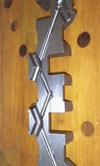Sealing oil drillings
 One of the functions of a crankshaft, besides playing its fundamental part in an engine's basic mechanism, is to transfer oil, especially to the con rod big-end bearings. In some cases, where all main bearings are directly fed from the main oil gallery in the cylinder block, and where drillings can take oil directly from the main bearing to the crankpin, there is no requirement to seal any drillings. However, in a great many cases, there is a need to reliably seal oil drillings, and there are a number of methods of doing this.
One of the functions of a crankshaft, besides playing its fundamental part in an engine's basic mechanism, is to transfer oil, especially to the con rod big-end bearings. In some cases, where all main bearings are directly fed from the main oil gallery in the cylinder block, and where drillings can take oil directly from the main bearing to the crankpin, there is no requirement to seal any drillings. However, in a great many cases, there is a need to reliably seal oil drillings, and there are a number of methods of doing this.
One method of transferring oil between main bearings and crankpins is to have oil drillings running along the length of the crankshaft, with drillings from the surfaces of the crankpins and main bearings intersecting these radially. Where the oil drillings break out of the crankshaft, we need to plug these holes. A simple solution is to tap the ends of the holes and plug them with a threaded bung. This can be as simple as a grubscrew used with a thread-sealing compound or thread-locking compound. A variation on this is to machine the screw to have a plain portion on its 'nose' and to fit an O-ring to provide a positive seal. To provide some extra security, where access allows, these can be 'staked' in place.
The use of a machined press-fit plug is common, and there are a number of proprietary types of two-piece high-pressure sealing plugs that are also popular. These usually have an outer piece which is a transition fit in the hole provided, and an inner piece which is a force fit, expanding the outer when fitted, providing a heavy press-fit without any chance of damaging the hole in the crankshaft.
While 'nose-fed' cranks do not represent a large proportion of race crankshafts, they are popularly used for short-stroke applications. In a nose-fed crankshaft, oil is introduced at the nose of the crankshaft on the crank axis, and is transferred along the crankshaft via drillings that are machined from the bevels next to each crankpin. Again, there is a need for these drillings to be reliably sealed. Such drillings can be responsible for locally high stresses and so real care is taken to design something that doesn't cause very high stress. Again though, threaded plugs or interference-fit plugs can be used, and where this is the case, it is common to stake them in place and use a sealing/retaining compound.
However, threads can be responsible for high levels of stress concentration; special taps that form a controlled radius at the major diameter of the internal thread are a good way to minimise the stress concentration factor. A better way though is to dispense with threaded plugs and look to another method of plug retention. If a plug can be located against a stop, a retaining clip can be used, and a groove to accept a round wire clip, similar to a piston-pin circlip, is a good way of keeping the stress concentration to a minimum.
Fig. 1 - The design of a reliable sealing method for the oil drillings in this nose-fed crankshaft needs careful thought
Written by Wayne Ward